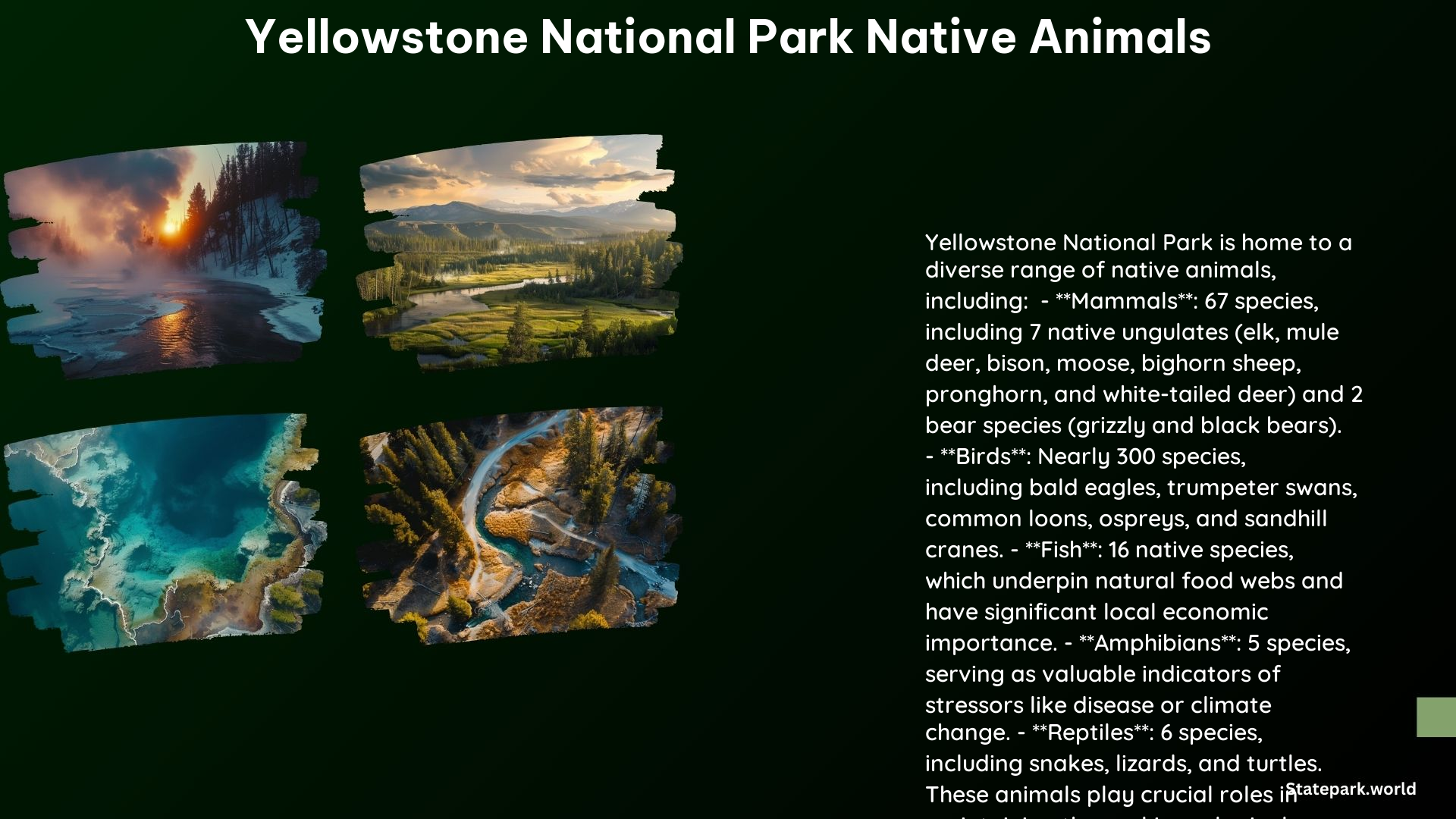Yellowstone National Park is a vast and diverse wilderness, home to a remarkable array of native animals. From the iconic bison and grizzly bears to the elusive mountain lions and wolves, the park’s wildlife is a testament to the richness and complexity of the natural world. In this blog post, we’ll delve into the fascinating world of Yellowstone’s native animals, exploring their unique characteristics, habitats, and the crucial role they play in the park’s delicate ecosystem.
Ungulates: The Grazing Giants of Yellowstone
Yellowstone is renowned for its large ungulate species, which include the majestic elk, the massive bison, the agile pronghorn, and the sure-footed bighorn sheep. These herbivores are the backbone of the park’s ecosystem, playing a vital role in shaping the landscape through their grazing and migratory patterns.
Elk (Cervus canadensis)
The most abundant large mammal in Yellowstone, elk are a common sight in areas like Mammoth Hot Springs, Gibbon Meadows, and Lamar Valley. These impressive creatures can weigh up to 1,000 pounds and are known for their distinctive antlers, which can reach up to 4 feet in length.
Bison (Bison bison)
The largest grazing mammals in Yellowstone, bison can weigh up to 1,800 pounds for males and 1,300 pounds for females. These nomadic grazers are a symbol of the American West and can move quickly when threatened, making them a must-see for visitors to the park.
Pronghorn (Antilocapra americana)
A unique and surviving member of a group of animals that evolved in North America, the pronghorn is the fastest land mammal in the Western Hemisphere, capable of reaching speeds of up to 55 miles per hour.
Bighorn Sheep (Ovis canadensis)
Migratory and found in the park’s mountainous regions, bighorn sheep are known for their impressive curved horns and their ability to navigate the rugged terrain with ease.
The Bears of Yellowstone: Grizzlies and Black Bears

Yellowstone is home to two species of bears: the grizzly bear and the black bear. Both are fascinating and awe-inspiring creatures, but they have distinct physical characteristics and behaviors.
Grizzly Bears (Ursus arctos horribilis)
Larger than black bears, grizzly bears have a distinctive hump on their shoulders and a dish-shaped face. They are powerful predators and omnivores, feeding on a variety of plants, insects, and even other animals.
Black Bears (Ursus americanus)
Smaller than grizzly bears, black bears have a longer snout and more pointed ears. They are also omnivores, but tend to be more opportunistic and adaptable in their feeding habits.
Other Mammals of Yellowstone
In addition to the large ungulates and bears, Yellowstone is home to a diverse array of other mammal species, including coyotes, wolves, bobcats, Canada lynx, mountain lions, and wolverines.
Coyotes (Canis latrans)
Abundant and intelligent animals, coyotes are often heard at dusk and dawn, their distinctive howls echoing through the park.
Wolves (Canis lupus)
Reintroduced to Yellowstone in 1995, wolves play a crucial role in the park’s ecosystem, helping to regulate the populations of other species and maintain the delicate balance of the natural world.
Mountain Lions (Puma concolor)
Also known as cougars, mountain lions are the largest of the cat species in Yellowstone. These elusive predators are skilled hunters, preying on a variety of animals, including deer and elk.
Feathered Residents: The Birds of Yellowstone
Yellowstone is also home to a diverse array of bird species, from the majestic bald eagles and ospreys to the diminutive mountain chickadees.
Bald Eagles (Haliaeetus leucocephalus)
Found in areas like Hayden Valley, Madison River, and Yellowstone Lake, bald eagles are a symbol of American wildlife and can be spotted soaring overhead or perched on the banks of the park’s waterways.
Ospreys (Pandion haliaetus)
Migratory birds that hunt fish and build nests in trees or pinnacles near water, ospreys are a common sight in Yellowstone during the warmer months.
Mountain Chickadees (Poecile gambeli)
These common songbirds, with their distinctive “chick-a-dee” call, can be found throughout the park, adding their cheerful presence to the natural soundscape.
Aquatic Life and Reptiles of Yellowstone
Yellowstone’s diverse ecosystem extends beyond the land, with a rich array of aquatic life and reptiles.
Native Fish Species
Yellowstone is home to 16 species of fish, which are crucial to the park’s ecosystem and have significant local economic importance.
Amphibians
The park is home to five species of amphibians, which serve as valuable indicators of environmental stressors like disease or climate change.
Reptiles
Yellowstone is home to six species of reptiles, including snakes, lizards, and turtles.
Yellowstone National Park is a true natural wonder, teeming with a diverse array of native animals that captivate and inspire visitors from around the world. By understanding and appreciating the unique characteristics and roles of these species, we can better protect and preserve this incredible ecosystem for generations to come.
References:
– https://en.wikipedia.org/wiki/List_of_animals_of_Yellowstone
– https://www.yellowstonenationalparklodges.com/connect/yellowstone-hot-spot/infographic-spot-these-plants-and-animals-in-yellowstone-national-park/
– https://destinationyellowstone.com/wildlife-of-yellowstone/
– https://www.nps.gov/yell/learn/nature/mammals.htm
– https://www.nps.gov/yell/learn/nature/wildlife.htm
